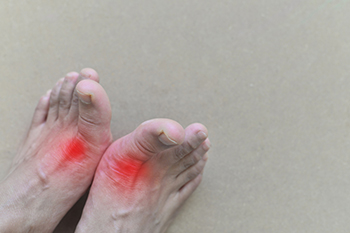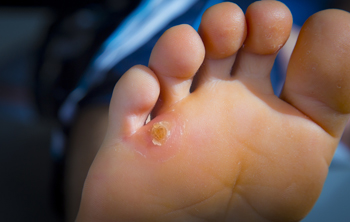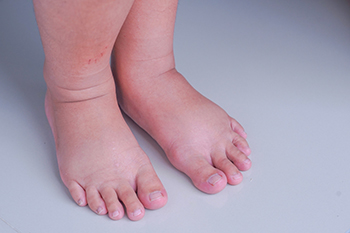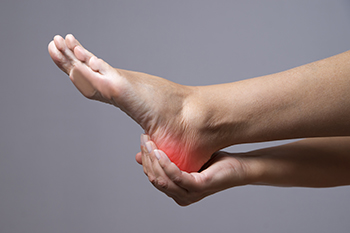Connect With Us
Blog
Blog

A broken ankle is painful. It can happen from falling and may affect one or more ankle bones. A partial break is considered to be minor, and as the name implies, is not completely cracked. A severely broken ankle happens when the ankle bone breaks in two or more places and can happen on one or both sides of the ankle. The majority of broken ankles require the attention of an expert medical professional, such as a podiatrist. Prior to that, resting and frequently elevating the foot may help to relieve swelling, and it may be helpful to take over-the-counter medicine for pain relief. After a proper diagnosis is performed, which generally consists of having an X-ray taken, treatment can begin. Many people wear a cast or a boot and often use crutches for mobility. During the recovery period, which can last up to 10 weeks, most activities will be temporarily stopped. This may help to give the affected ankle the best chance for a full recovery. If you have broken your ankle, it is strongly suggested that you schedule an appointment with a podiatrist as quickly as possible who can properly diagnose and treat it.
Broken ankles need immediate treatment. If you are seeking treatment, contact Cary Golub, DPM from New York. Our doctor can provide the care you need to keep you pain-free and on your feet.
Broken Ankles
A broken ankle is experienced when a person fractures their tibia or fibula in the lower leg and ankle area. Both of these bones are attached at the bottom of the leg and combine to form what we know to be our ankle.
When a physician is referring to a break of the ankle, he or she is usually referring to a break in the area where the tibia and fibula are joined to create our ankle joint. Ankles are more prone to fractures because the ankle is an area that suffers a lot of pressure and stress. There are some obvious signs when a person experiences a fractured ankle, and the following symptoms may be present.
Symptoms of a Fractured Ankle
- Excessive pain when the area is touched or when any pressure is placed on the ankle
- Swelling around the area
- Bruising of the area
- Area appears to be deformed
If you suspect an ankle fracture, it is recommended to seek treatment as soon as possible. The sooner you have your podiatrist diagnose the fracture, the quicker you’ll be on the way towards recovery.
If you have any questions, please feel free to contact our offices located in Williston Park, and Long Beach, NY . We offer the newest diagnostic and treatment technologies for all your foot care needs.

If you have experienced sudden pain in the big toe and it is accompanied by swelling, you may have gout. This is especially likely if you have been ill or sustained a recent injury. Gout is a type of inflammatory arthritis that results in a buildup of uric acid in the blood. Uric acid is a chemical naturally produced by the body that helps break down foods containing purines. Once this happens, uric acid and purines are both released from the body through urine. If uric acid is not released from the body, it can build up and turn into urate crystals, which can settle in soft tissues and joints. This in turn can turn into inflammation or gout. Gout is more common in men and is often hereditary. It is also more common among those who eat foods that are high in purines or have other conditions, like high cholesterol, high blood pressure, or diabetes. Gout can affect other parts of the body but often presents itself as pain in the big toe. If this description fits you, it is suggested that you see a podiatrist so that you can get this condition under control in a timely manner.
Gout is a foot condition that requires certain treatment and care. If you are seeking treatment, contact Cary Golub, DPM from New York. Our doctor will treat your foot and ankle needs.
What Is Gout?
Gout is a type of arthritis caused by a buildup of uric acid in the bloodstream. It often develops in the foot, especially the big toe area, although it can manifest in other parts of the body as well. Gout can make walking and standing very painful and is especially common in diabetics and the obese.
People typically get gout because of a poor diet. Genetic predisposition is also a factor. The children of parents who have had gout frequently have a chance of developing it themselves.
Gout can easily be identified by redness and inflammation of the big toe and the surrounding areas of the foot. Other symptoms include extreme fatigue, joint pain, and running high fevers. Sometimes corticosteroid drugs can be prescribed to treat gout, but the best way to combat this disease is to get more exercise and eat a better diet.
If you have any questions please feel free to contact our offices located in Williston Park, and Long Beach, NY . We offer the newest diagnostic and treatment technologies for all your foot and ankle needs.

No one likes toe pain. Even though the toes are small parts of the body, experiencing toe pain is no joke. There are many different potential sources of toe pain. Capsulitis is one interesting type of foot condition that almost exclusively affects the foot's second toe. The condition occurs when the ligament structure at the joint of the second toe becomes significantly inflamed. As a result of this condition, an individual might experience any number of symptoms. Most importantly, a patient with capsulitis can experience pain in the ball of the foot under the affected toe, usually the second toe. It is important to note that capsulitis can sometimes, although rarely, impact the third toe. If you struggle with toe pain, it is highly recommended that you contact a podiatrist today for treatment.
Toe pain can disrupt your daily activities. If you have any concerns, contact Cary Golub, DPM of New York. Our doctor can provide the care you need to keep you pain-free and on your feet.
What Causes Toe Pain?
Most severe toe pain is caused due to a sports injury, trauma from dropping something heavy on the toe, or bumping into something rigid. Other problems can develop over time for various reasons.
Toe pain can be caused by one or more ailments. The most common include:
- Trauma
- Sports injury
- Wearing shoes that are too tight
- Arthritis
- Gout
- Corns and calluses
- Hammertoe
- Bunions
- Blisters
- Ingrown toenails
- Sprains
- Fractures (broken bones)
- Dislocations
When to See a Podiatrist
- Severe pain
- Persistent pain that lasts more than a week
- Signs of infection
- Continued swelling
- Pain that prevents walking
Diagnosis
In many cases the cause of toe pain is obvious, but in others, a podiatrist may want to use more advanced methods to determine the problem. These can range from simple visual inspections and sensation tests to X-rays and MRI scans. Prior medical history, family medical history, and any recent physical traumatic events will all be taken into consideration for a proper diagnosis.
Treatment
Treatments for toe pain and injuries vary and may include shoe inserts, padding, taping, medicines, injections, and in some cases, surgery. If you believe that you have broken a toe, please see a podiatrist as soon as possible.
If you have any questions please feel free to contact our offices located in Williston Park, and Long Beach, NY . We offer the newest diagnostic tools and technology to treat your foot and ankle needs.

Corns on the feet develop as a result of excess pressure that is generally caused by the shoes that are worn. There may also be existing medical conditions that can lead to getting a corn, including hammer toe and bunions. Corns can cause extreme pain and discomfort, despite their small size. They are defined as small areas of hardened skin that forms on top of the toes, or on the side of the pinky toe. Additionally, corns may form on the soles of the feet, and they are referred to as seed corns. This type of corn is often associated with having dry skin, and may be found in clusters on the bottom of the feet. Applying a good moisturizer may help to keep the skin soft, and can possibly reduce the number of seed corns that can develop. Shoes may be difficult to wear, which may be from the weight the feet endure while walking or standing. Many patients have found temporary relief when their foot is soaked in warm water, and from wearing shoes and socks that fit correctly. Corns that will not diminish or disappear is often a reason a podiatrist is contacted. If this applies to you, please consult this type of doctor who can effectively treat corns on the feet.
If you have any concerns regarding your feet and ankles, contact Cary Golub, DPM of New York. Our doctor will treat your foot and ankle needs.
Corns: What Are They? and How Do You Get Rid of Them?
Corns can be described as areas of the skin that have thickened to the point of becoming painful or irritating. They are often layers and layers of the skin that have become dry and rough, and are normally smaller than calluses.
Ways to Prevent Corns
There are many ways to get rid of painful corns such as wearing:
- Well-fitting socks
- Comfortable shoes that are not tight around your foot
- Shoes that offer support
Treating Corns
Treatment of corns involves removing the dead skin that has built up in the specific area of the foot. Consult with Our doctor to determine the best treatment option for your case of corns.
If you have any questions please feel free to contact our offices located in Williston Park, and Long Beach, NY . We offer the newest diagnostic and treatment technologies for all your foot and ankle needs.

Many runners experience stiffness in their ankles after running. This is a common side effect of the amount of force that passes through the ankle during a run. It can affect the range of motion and mobility of the ankle. In some cases, it may become difficult to bear weight and lead to limping. Studies have indicated that the faster you run, the more likely you are to develop ankle stiffness. Further, the way you run may affect the ankle as well. For example, a heel-first footstrike is more likely to contribute to ankle stiffness than a toe-first style of running. Other possible causes of ankle stiffness include a sprain, arthritis, or plantar fasciitis. Lastly, check the wear and tear on your running shoes. It may be time to replace them, which is recommended by running experts between 350 and 500 miles. Shoes that lack ample support may contribute to ankle stiffness after running. For an examination and diagnosis to determine the cause of your ankle stiffness, it is suggested that you consult a podiatrist before it gets worse.
Ankle pain can be caused by a number of problems and may be potentially serious. If you have ankle pain, consult with Cary Golub, DPM from New York. Our doctor will assess your condition and provide you with quality foot and ankle treatment.
Ankle pain is any condition that causes pain in the ankle. Due to the fact that the ankle consists of tendons, muscles, bones, and ligaments, ankle pain can come from a number of different conditions.
Causes
The most common causes of ankle pain include:
- Types of arthritis (rheumatoid, osteoarthritis, and gout)
- Ankle sprains
- Broken ankles
- Achilles tendinitis
- Achilles tendon rupture
- Stress fractures
- Bursitis
- Tarsal tunnel syndrome
- Plantar fasciitis
Symptoms
Symptoms of ankle injury vary based upon the condition. Pain may include general pain and discomfort, swelling, aching, redness, bruising, burning or stabbing sensations, and/or loss of sensation.
Diagnosis
Due to the wide variety of potential causes of ankle pain, podiatrists will utilize a number of different methods to properly diagnose ankle pain. This can include asking for personal and family medical histories and of any recent injuries. Further diagnosis may include sensation tests, a physical examination, and potentially x-rays or other imaging tests.
Treatment
Just as the range of causes varies widely, so do treatments. Some more common treatments are rest, ice packs, keeping pressure off the foot, orthotics and braces, medication for inflammation and pain, and surgery.
If you have any questions, please feel free to contact our offices located in Williston Park, and Long Beach, NY . We offer the newest diagnostic and treatment technologies for all your foot care needs.

The medical name for flat feet is called pes planus. The absence of the arch is easily noticed as the foot lies flat while standing on the floor. This can affect the foot structure, and as a result, many people have foot pain. Most babies are born with flat feet, and the arch will develop in the teenage years. In some adults, the arch never forms, and they may experience pain which can interfere with completing daily activities. Having surgery on flat feet may be an option for relief. This type of reconstruction surgery consists of repairing the tendons, ligaments, and bone structure that can reshape the foot and ultimately support the arch. There are several pros and cons of having this type of surgery performed. If you have flat feet and are considering surgery, it is strongly suggested that you speak with a podiatrist who can determine if this is the right decision for you.
Foot surgery is sometimes necessary to treat a foot ailment. To learn more, contact Cary Golub, DPM of New York. Our doctor will assist you with all of your foot and ankle needs.
When Is Surgery Necessary?
Foot and ankle surgery is generally reserved for cases in which less invasive, conservative procedures have failed to alleviate the problem. Some of the cases in which surgery may be necessary include:
- Removing foot deformities like bunions and bone spurs
- Severe arthritis that has caused bone issues
- Cosmetic reconstruction
What Types of Surgery Are There?
The type of surgery you receive will depend on the nature of the problem you have. Some of the possible surgeries include:
- Bunionectomy for painful bunions
- Surgical fusion for realignment of bones
- Neuropathy decompression surgery to treat nerve damage
Benefits of Surgery
Although surgery is usually a last resort, it can provide more complete pain relief compared to non-surgical methods and may allow you to finally resume full activity.
Surgical techniques have also become increasingly sophisticated. Techniques like endoscopic surgery allow for smaller incisions and faster recovery times.
If you have any questions please feel free to contact our offices located in Williston Park, and Long Beach, NY . We offer the newest diagnostic and treatment technologies for all your foot and ankle needs.

Swelling is defined as specific areas of the body becoming larger, and this pertains to the feet and ankles. There are various reasons for the feet to swell, including enduring a foot or ankle injury, pregnancy, and medical conditions such as lymphedema. Additionally, taking specific medications may cause the feet to swell. These can consist of hormones, antidepressants, or medicine for diabetes. Research has shown that eating certain foods may be linked to having swollen feet. Foods that are regularly eaten such as processed, refined, and salted may increase the chances of developing swollen feet. Foods that are made with a large amount of sugar and fats such as vegetable oil may also be linked to having swollen feet. If your feet and ankles are swollen and become uncomfortable, please consult with a podiatrist who can guide you toward determining the reason for this condition and offer correct treatment methods.
Swollen feet can be a sign of an underlying condition. If you have any concerns, contact Cary Golub, DPM of New York. Our doctor can provide the care you need to keep you pain-free and on your feet.
Swollen feet are a common ailment among pregnant women and people who stand or sit for extended periods. Aging may increase the possibility of swollen feet and patients who are obese often notice when their feet are swelling too. There may be medical reasons why swollen feet occur:
- Phlebitis - A condition that causes the veins to become inflamed and can also cause leg pain.
- Liver disease - This may lead to low blood levels of albumin which is a protein. This can cause fluid in the blood to pass into the tissues and several areas of the body can become swollen.
- Heart failure - When the heart doesn’t pump properly the blood that is normally pumped back to the heart can pool in the veins of the legs causing swollen feet.
- Kidney disease - One of the main functions of the kidneys is releasing excess fluid in the body. This type of condition can make it difficult for the kidneys to function properly, and as a result the feet may become swollen.
- Deep-vein thrombosis (DVT)- This is a serious condition where blood clots form in the veins of the legs. They can block the return of blood from the legs to the heart which may cause the feet to swell. It is important to be treated by a podiatrist if this condition is present.
Swollen feet can also be caused by bone and tendon conditions, including fractures, arthritis, and tendinitis. Additionally, there may be skin and toenail conditions and an infection may cause the feet to swell. Patients who take medicine to treat high blood pressure may be prone to getting swollen feet.
Many patients elevate their feet to help relieve the swelling and this is generally a temporary remedy. When a podiatrist is consulted the reason behind the swelling can be uncovered and subsequently treated.
If you have any questions please feel free to contact our offices located in Williston Park, and Long Beach, NY . We offer the newest diagnostic tools and technology to treat your foot and ankle needs.

Heel pain can happen for a variety of reasons. While it can be caused by a systemic illness, such as gout or rheumatoid arthritis, it often develops from overuse. Common causes of heel pain include plantar fasciitis, heel spurs, and Achilles tendonitis. Plantar fasciitis is an inflammation of the plantar fascia, the band of tissue that runs from the heel to the toes on the sole of the foot. This can happen when the plantar fascia is overloaded or overstretched and small tears may develop. A heel spur is an abnormal bony growth at the junction of the plantar fascia and heel bone. A spur can come from strain on the plantar fascia and muscles of the foot. Achilles tendonitis is an inflammation of the Achilles tendon. It is triggered by overuse, particularly excessive jumping in sports. With all these conditions, ill fitting or worn out shoes can aggravate the problem. If you have heel pain that does not respond to rest, shoes that fit well, and are appropriate for your activity, please see a podiatrist who can properly diagnose the problem and provide treatment.
Many people suffer from bouts of heel pain. For more information, contact Cary Golub, DPM of New York. Our doctor can provide the care you need to keep you pain-free and on your feet.
Causes of Heel Pain
Heel pain is often associated with plantar fasciitis. The plantar fascia is a band of tissues that extends along the bottom of the foot. A rip or tear in this ligament can cause inflammation of the tissue.
Achilles tendonitis is another cause of heel pain. Inflammation of the Achilles tendon will cause pain from fractures and muscle tearing. Lack of flexibility is also another symptom.
Heel spurs are another cause of pain. When the tissues of the plantar fascia undergo a great deal of stress, it can lead to ligament separation from the heel bone, causing heel spurs.
Why Might Heel Pain Occur?
- Wearing ill-fitting shoes
- Wearing non-supportive shoes
- Weight change
- Excessive running
Treatments
Heel pain should be treated as soon as possible for immediate results. Keeping your feet in a stress-free environment will help. If you suffer from Achilles tendonitis or plantar fasciitis, applying ice will reduce the swelling. Stretching before an exercise like running will help the muscles. Using all these tips will help make heel pain a condition of the past.
If you have any questions please contact our offices located in Williston Park, and Long Beach, NY . We offer the newest diagnostic and treatment technologies for all your foot and ankle needs.
Blog Archives
- 2025
- 2024
- 2023
- 2022
- 2021
- 2020


